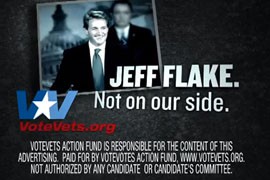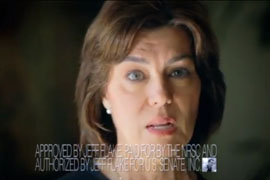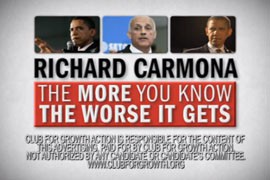Cronkite News has moved to a new home at cronkitenews.azpbs.org. Use this site to search archives from 2011 to May 2015. You can search the new site for current stories.
Political TV ad buys approach $30 million in Arizona, and still counting
WASHINGTON – Political ads peppering Arizona airwaves in this contentious election season have cost at least $29.4 million, based on newly mandated electronic filings to the Federal Communications Commission.
The records measure only part of the money that is being spent on political ads, and they exist in a jumble of inconsistent forms and names.
But one thing is certain from the reports: Not only have political groups bought millions of dollars of ads since August, but they are poised to spend millions more between now and Election Day.
Many ads have already been bought but have not been documented by the largely volunteer effort to shine light on political television ads by groups like the Sunlight Foundation and ProPublica. In less than an hour Friday, for example, filings for Arizona stations reported by the non-profit ProPublica’s Free the Files website jumped by more than $1 million.
Campaigns for Senate candidates Richard Carmona and Rep. Jeff Flake, R-Mesa, appear to be the top spenders on TV ads in the Phoenix market in a tally of more than 800 public-record ad contracts submitted to the FCC by broadcasters there.
Until this election season, broadcasters’ “political files” were open to public inspection, but were kept on paper records at the station for in-person review.
The FCC ruled in April that CBS, ABC, NBC and Fox stations in the top 50 television markets must post new additions to their political files to an FCC-hosted database. The mandate, which took effect Aug. 2, will expand to all domestic stations and markets in July 2014.
One shortcoming of the new FCC rule is that it does not require stations to use a specific form, allowing for sprawling inconsistencies in the database.
That is not surprising to the National Association of Broadcasters, which had challenged the mandate from the outset.
“It’s a brand-new rule that the FCC rushed to get in place … before the election,” said Dennis Wharton, NAB’s executive vice president of communications. “There was a certain hastiness in adopting this rule and we’re doing our best to comply.”
An FCC official said in an email that the “commission is not considering requiring a unified form at this time,” but that work is underway to launch tools “to assist visitors with analyzing and sorting data, but our rules do not require the aggregation of data.”
Experts are split on the immediate value of the information.
Ruth Jones, an Arizona State University political science professor, said the ruling is “a step forward in terms of providing information and transparency, but it only goes so far.”
“The first time through … we’ll learn by looking at these data, how onerous the rule is on the stations and how useful it is for analysts,” Jones said.
But Shanto Iyengar, a political science professor at Stanford University, was more skeptical about the extent to which the policy enhances transparency.
“The FCC ruling only requires location and placement of the end product,” Iyengar said. “I’m not sure it’s a step forward. I think it will incentivize the press into more horse-race coverage of political campaigns.”
The NAB had petitioned and eventually sued the FCC for imposing an “arbitrary and capricious” burden on station staffs and for exposing detailed ad pricing information.
“There’s a fundamental unfairness to a law that singles out only broadcast TV stations,” said Wharton. “When we are required to provide our fiercest competitors with individual ad rates, it causes us some concern.
“Cable TV, satellite TV and Internet companies … none of those industries are subject to this new rule,” he said.
Demand drives up ad rates in the lead-up to the elections, but Wharton said broadcasters are required to give candidates about a 30 percent discount. Outside groups such as super PACs are not eligible for the cheaper rate.
The FCC database is potentially a vehicle for monitoring spending by super-PAC-aligned non-profit groups that are neither required to file expenditure reports to the Federal Election Commission nor to disclose their donors.
Despite the glut of new data, however, Jones said true spending levels may still be hard to discern.
“What we don’t know necessarily is who’s funding American Crossroads or Club for Growth,” she said. “It’s pretty muddled.”









